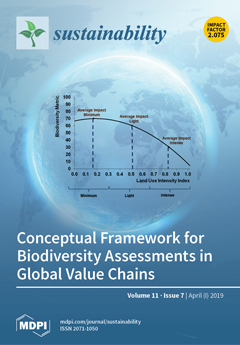Desulphurization of oil-based fuels is common practice to mitigate the ecological burden to ecosystems and human health of SO
x emissions. In many countries, fuels for vehicles are restricted to 10 ppm sulphur. For marine fuels, low sulphur contents are under discussion. The
[...] Read more.
Desulphurization of oil-based fuels is common practice to mitigate the ecological burden to ecosystems and human health of SO
x emissions. In many countries, fuels for vehicles are restricted to 10 ppm sulphur. For marine fuels, low sulphur contents are under discussion. The environmental impact of desulphurization processes is, however, quite high: (1) The main current source for industrial hydrogen is Steam Methane Reforming (SMR), with a rather high level of CO
2 emissions, (2) the hydrotreating process, especially below 150 ppm, needs a lot of energy. These two issues lead to three research questions: (a) What is the overall net ecological benefit of the current desulphurization practice? (b) At which sulfphur ppm level in the fuel is the additional ecological burden of desulphurization higher than the additional ecological benefit of less SO
x pollution from combustion? (c) To what extent can cleaner hydrogen processes improve the ecological benefit of diesel desulphurization? In this paper we use LCA to analyze the processes of hydrotreatment, the recovery of sulphur via amine treating of H
2S, and three processes of hydrogen production: SMR without Carbon Capture and Sequestration (CCS), SMR with 53% and 90% CCS, and water electrolysis with two types of renewable energy. The prevention-based eco-costs system is used for the overall comparison of the ecological burden and the ecological benefit. The ReCiPe system was applied as well but appeared not suitable for such a comparison (other damage-based indicators cannot be applied either). The overall conclusion is that (1) the overall net ecological benefit of hydrogen-based Ultra Low Sulphur Diesel is dependent of local conditions, but is remarkably high, (2) desulphurization below 10 ppm is beneficial for big cities, and (3) cleaner production of hydrogen reduces eco-cost by a factor 1.8–3.4.
Full article





